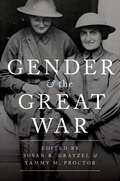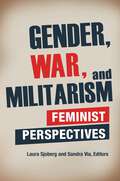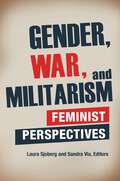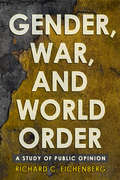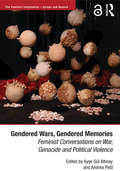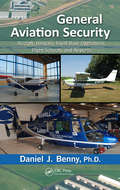- Table View
- List View
Gender Inequalities in Southern Europe: Woman, Work and Welfare in the 1990s
by María José González Teresa Jurado Manuela NaldiniPresenting studies of the situation on gender inequalities and associated pattern of work and welfare in all southern European countries, this work focuses on the interaction of the three major societal institutions - the State, the family and the labour market.
Gender Inequalities in Southern Europe: Woman, Work and Welfare in the 1990s
by Maria Jose Gonzalez Teresa Jurado Manuela NaldiniPresenting studies of the situation on gender inequalities and associated pattern of work and welfare in all southern European countries, this work focuses on the interaction of the three major societal institutions - the State, the family and the labour market.
Gender Integration in NATO Military Forces: Cross-national Analysis (Gender in a Global/Local World)
by Lana ObradovicNumerous states have passed gender integration legislation permanently admitting women into their military forces. As a result, states have dramatically increased women’s numbers, and improved gender equality by removing a number of restrictions. Yet despite changes and initiatives on both domestic and international levels to integrate gender perspectives into the military, not all states have improved to the same extent. Some have successfully promoted gender integration in the ranks by erasing all forms of discrimination, but others continue to impede it by setting limitations on equal access to careers, combat, and ranks. Why do states abandon their policies of exclusion and promote gender integration in a way that women’s military participation becomes an integral part of military force? By examining twenty-four NATO member states, this book argues that civilian policymakers and military leadership no longer surrender to parochial gendered division of the roles, but rather support integration to meet the recruitment numbers due to military modernization, professionalization and technological advancements. Moreover, it proposes that increased pressure by the United Nations to integrate gender into security and NATO seeking standardization and consistency on the international level, and women’s movements on the domestic level, are contributing to greater gender integration in the military.
Gender Integration in NATO Military Forces: Cross-national Analysis (Gender in a Global/Local World)
by Lana ObradovicNumerous states have passed gender integration legislation permanently admitting women into their military forces. As a result, states have dramatically increased women’s numbers, and improved gender equality by removing a number of restrictions. Yet despite changes and initiatives on both domestic and international levels to integrate gender perspectives into the military, not all states have improved to the same extent. Some have successfully promoted gender integration in the ranks by erasing all forms of discrimination, but others continue to impede it by setting limitations on equal access to careers, combat, and ranks. Why do states abandon their policies of exclusion and promote gender integration in a way that women’s military participation becomes an integral part of military force? By examining twenty-four NATO member states, this book argues that civilian policymakers and military leadership no longer surrender to parochial gendered division of the roles, but rather support integration to meet the recruitment numbers due to military modernization, professionalization and technological advancements. Moreover, it proposes that increased pressure by the United Nations to integrate gender into security and NATO seeking standardization and consistency on the international level, and women’s movements on the domestic level, are contributing to greater gender integration in the military.
Gender, Sex and the Postnational Defense: Militarism and Peacekeeping (Oxford Studies in Gender and International Relations)
by Annica KronsellThis book explores the post-national defense and its gender implications. Specifically, it explores how the United Nations Security Council resolution to increase the participation of women in peace negotiations, humanitarian planning, peacekeeping operations, post-conflict peacebuilding and governance has influenced the organization and policy practices of the post-national defense.
GENDER & THE GREAT WAR C
by Susan R. Grayzel Tammy M. ProctorThe centenary of the First World War in 2014-18 offers an opportunity to reflect upon the role of gender history in shaping our understanding of this pivotal international event. From the moment of its outbreak, the gendered experiences of the war have been seen by contemporary observers and postwar commentators and scholars as being especially significant for shaping how the war can and must be understood. The negotiating of ideas about gender by women and men across vast reaches of the globe characterizes this modern, instrumental conflict. Over the past twenty-five years, as the scholarship on gender and this war has grown, there has never been a forum such as the one presented here that placed so many of the varying threads of this complex historiography into conversation with one another in a manner that is at once accessible and provocative. Given the vast literature on the war itself, scholarship on gender and various themes and topics provides students as well as scholars with a chance to think not only about the subject of the war but also the methodological implications of how historians have approached it. While many studies have addressed the national or transnational narrative of women in the war, none address both femininity and masculinity, and the experiences of both women and men across the same geographic scope as the studies presented in this volume.
Gender, War, and Militarism: Feminist Perspectives (Praeger Security International)
by Laura Sjoberg Sandra ViaThis compelling, interdisciplinary compilation of essays documents the extensive, intersubjective relationships between gender, war, and militarism in 21st-century global politics.Feminist scholars have long contended that war and militarism are fundamentally gendered. Gender, War, and Militarism: Feminist Perspectives provides empirical evidence, theoretical innovation, and interdisciplinary conversation on the topic, while explicitly—and uniquely—considering the links between gender, war, and militarism. Essentially an interdisciplinary conversation between scholars studying gender in political science, anthropology, and sociology, the essays here all turn their attention to the same questions. How are war and militarism gendered?Seventeen innovative explanations of different intersections of the gendering of global politics and global conflict examine the theoretical relationship between gender, militarization, and security; the deployment of gender and sexuality in times of conflict; sexual violence in war and conflict; post-conflict reconstruction; and gender and militarism in media and literary accounts of war. Together, these essays make a coherent argument that reveals that, although it takes different forms, gendering is a constant feature of 21st-century militarism.
Gender, War, and Militarism: Feminist Perspectives (Praeger Security International)
by Laura Sjoberg Sandra E. ViaThis compelling, interdisciplinary compilation of essays documents the extensive, intersubjective relationships between gender, war, and militarism in 21st-century global politics.Feminist scholars have long contended that war and militarism are fundamentally gendered. Gender, War, and Militarism: Feminist Perspectives provides empirical evidence, theoretical innovation, and interdisciplinary conversation on the topic, while explicitly—and uniquely—considering the links between gender, war, and militarism. Essentially an interdisciplinary conversation between scholars studying gender in political science, anthropology, and sociology, the essays here all turn their attention to the same questions. How are war and militarism gendered?Seventeen innovative explanations of different intersections of the gendering of global politics and global conflict examine the theoretical relationship between gender, militarization, and security; the deployment of gender and sexuality in times of conflict; sexual violence in war and conflict; post-conflict reconstruction; and gender and militarism in media and literary accounts of war. Together, these essays make a coherent argument that reveals that, although it takes different forms, gendering is a constant feature of 21st-century militarism.
Gender, War, and World Order: A Study of Public Opinion (Cornell Studies in Security Affairs)
by Richard C. EichenbergMotivated by the lack of scholarly understanding of the substantial gender difference in attitudes toward the use of military force, Richard C. Eichenberg has mined a massive data set of public opinion surveys to draw new and important conclusions. By analyzing hundreds of such surveys across more than sixty countries, Gender, War, and World Order offers researchers raw data, multiple hypotheses, and three major findings.Eichenberg poses three questions of the data: Are there significant differences in the opinions of men and women on issues of national security? What differences can be discerned across issues, culture, and time? And what are the theoretical and political implications of these attitudinal differences? Within this framework, Gender, War, and World Order compares gender difference on military power, balance of power, alliances, international institutions, the acceptability of war, defense spending, defense/welfare compromises, and torture. Eichenberg concludes that the centrality of military force, violence, and war is the single most important variable affecting gender difference; that the magnitude of gender difference on security issues correlates with the economic development and level of gender equality in a society; and that the country with the most consistent gender polarization across the widest range of issues is the United States.
Gendered Wars, Gendered Memories: Feminist Conversations on War, Genocide and Political Violence (The Feminist Imagination - Europe and Beyond)
by Ay 351 e Gül Altı Nay Andrea Pet 337The Introduction of this book is freely available as a downloadable Open Access PDF under a Creative Commons Attribution-Non Commercial-No Derivatives 4.0 license available at http://www.taylorfrancis.com/books/e/9781315584225 The twentieth century has been a century of wars, genocides and violent political conflict; a century of militarization and massive destruction. It has simultaneously been a century of feminist creativity and struggle worldwide, witnessing fundamental changes in the conceptions and everyday practices of gender and sexuality. What are some of the connections between these two seemingly disparate characteristics of the past century? And how do collective memories figure into these connections? Exploring the ways in which wars and their memories are gendered, this book contributes to the feminist search for new words and new methods in understanding the intricacies of war and memory. From the Italian and Spanish Civil Wars to military regimes in Turkey and Greece, from the Armenian genocide and the Holocaust to the wars in Abhazia, East Asia, Iraq, Afghanistan, former Yugoslavia, Israel and Palestine, the chapters in this book address a rare selection of contexts and geographies from a wide range of disciplinary perspectives. In recent years, feminist scholarship has fundamentally changed the ways in which pasts, particularly violent pasts, have been conceptualized and narrated. Discussing the participation of women in war, sexual violence in times of conflict, the use of visual and dramatic representations in memory research, and the creative challenges to research and writing posed by feminist scholarship, Gendered Wars, Gendered Memories will appeal to scholars working at the intersection of military/war, memory, and gender studies, seeking to chart this emerging territory with ’feminist curiosity’.
Gendered Wars, Gendered Memories: Feminist Conversations on War, Genocide and Political Violence (The Feminist Imagination - Europe and Beyond)
by Ayşe Gül AltinayThe Introduction of this book is freely available as a downloadable Open Access PDF under a Creative Commons Attribution-Non Commercial-No Derivatives 4.0 license available at http://www.taylorfrancis.com/books/e/9781315584225 The twentieth century has been a century of wars, genocides and violent political conflict; a century of militarization and massive destruction. It has simultaneously been a century of feminist creativity and struggle worldwide, witnessing fundamental changes in the conceptions and everyday practices of gender and sexuality. What are some of the connections between these two seemingly disparate characteristics of the past century? And how do collective memories figure into these connections? Exploring the ways in which wars and their memories are gendered, this book contributes to the feminist search for new words and new methods in understanding the intricacies of war and memory. From the Italian and Spanish Civil Wars to military regimes in Turkey and Greece, from the Armenian genocide and the Holocaust to the wars in Abhazia, East Asia, Iraq, Afghanistan, former Yugoslavia, Israel and Palestine, the chapters in this book address a rare selection of contexts and geographies from a wide range of disciplinary perspectives. In recent years, feminist scholarship has fundamentally changed the ways in which pasts, particularly violent pasts, have been conceptualized and narrated. Discussing the participation of women in war, sexual violence in times of conflict, the use of visual and dramatic representations in memory research, and the creative challenges to research and writing posed by feminist scholarship, Gendered Wars, Gendered Memories will appeal to scholars working at the intersection of military/war, memory, and gender studies, seeking to chart this emerging territory with ’feminist curiosity’.
Gendering Counterinsurgency: Performativity, Embodiment and Experience in the Afghan ‘Theatre of War’ (War, Politics and Experience)
by Synne L. DyvikThis book analyses the various ways counterinsurgency in Afghanistan is gendered. The book examines the US led war in Afghanistan from 2001 onwards, including the invasion, the population-centric counterinsurgency operations and the efforts to train a new Afghan military charged with securing the country when the US and NATO withdrew their combat forces in 2014. Through an analysis of key counterinsurgency texts and military memoirs, the book explores how gender and counterinsurgency are co-constitutive in numerous ways. It discusses the multiple military masculinities that counterinsurgency relies on, the discourse of ‘cultural sensitivity’, and the deployment of Female Engagement Teams (FETs). Gendering Counterinsurgency demonstrates how population-centric counterinsurgency doctrine and practice can be captured within a gendered dynamic of ‘killing and caring’ – reliant on physical violence, albeit mediated through ‘armed social work’. This simultaneously contradictory and complementary dynamic cannot be understood without recognising how the legitimation and the practice of this war relied on multiple gendered embodied performances of masculinities and femininities. Developing the concept of ‘embodied performativity’ this book shows how the clues to understanding counterinsurgency, as well as gendering war more broadly are found in war’s everyday gendered manifestations. This book will be of much interest to students of counterinsurgency warfare, gender politics, governmentality, biopolitics, critical war studies, and critical security studies in general.
Gendering Counterinsurgency: Performativity, Embodiment and Experience in the Afghan ‘Theatre of War’ (War, Politics and Experience)
by Synne L. DyvikThis book analyses the various ways counterinsurgency in Afghanistan is gendered. The book examines the US led war in Afghanistan from 2001 onwards, including the invasion, the population-centric counterinsurgency operations and the efforts to train a new Afghan military charged with securing the country when the US and NATO withdrew their combat forces in 2014. Through an analysis of key counterinsurgency texts and military memoirs, the book explores how gender and counterinsurgency are co-constitutive in numerous ways. It discusses the multiple military masculinities that counterinsurgency relies on, the discourse of ‘cultural sensitivity’, and the deployment of Female Engagement Teams (FETs). Gendering Counterinsurgency demonstrates how population-centric counterinsurgency doctrine and practice can be captured within a gendered dynamic of ‘killing and caring’ – reliant on physical violence, albeit mediated through ‘armed social work’. This simultaneously contradictory and complementary dynamic cannot be understood without recognising how the legitimation and the practice of this war relied on multiple gendered embodied performances of masculinities and femininities. Developing the concept of ‘embodied performativity’ this book shows how the clues to understanding counterinsurgency, as well as gendering war more broadly are found in war’s everyday gendered manifestations. This book will be of much interest to students of counterinsurgency warfare, gender politics, governmentality, biopolitics, critical war studies, and critical security studies in general.
Gendering The Crusades (PDF)
by S. B. Edgington Sarah LambertThis work provides an exploration of the issue of gender in relation to the crusades. It discusses a range of subjects, from the medieval construction of gender to the military participation of women in the crusades.
Gendering Human Security in Afghanistan: In a Time of Western Intervention (Routledge Studies in Human Security)
by Ben WalterThis book employs the concept of human security to show what the term means from the perspective of women in Afghanistan. It engages with a well-established debate in academic and policy-making contexts regarding the utility of human security as a framework for understanding and redressing conflict. The book argues that this concept allows the possibility of articulating the substantive experiences of violence and marginalisation experienced by people in local settings as well as their own struggles towards a secure and happy life. In this regard, it goes a long way to making sense of the complex dynamics of conflict which have confounded Western policy-makers in their ongoing state-building mission in Afghanistan. However, despite this inherent potential, the idea of human security still needs refinement. Crucially, it has benefitted from critical feminist and critical social theories which provide the conceptual and methodological depth necessary to apprehend what a progressive ethical program of security looks like and how it can be furthered. Using this framework, the work provides a critical reconstruction of the effect of the US-led Western Intervention on women’s experiences of (in)security in the three provincial contexts of Nangarhar, Bamiyan and Kabul. This reconstruction is drawn from a wealth of historical and contemporary sociological research alongside original fieldwork undertaken in Delhi, India, during 2011 with women and men from the country’s different communities. This book will be of much interest to students of human security, state-building, gender politics, war and conflict studies and IR in general.
Gendering Human Security in Afghanistan: In a Time of Western Intervention (Routledge Studies in Human Security)
by Ben WalterThis book employs the concept of human security to show what the term means from the perspective of women in Afghanistan. It engages with a well-established debate in academic and policy-making contexts regarding the utility of human security as a framework for understanding and redressing conflict. The book argues that this concept allows the possibility of articulating the substantive experiences of violence and marginalisation experienced by people in local settings as well as their own struggles towards a secure and happy life. In this regard, it goes a long way to making sense of the complex dynamics of conflict which have confounded Western policy-makers in their ongoing state-building mission in Afghanistan. However, despite this inherent potential, the idea of human security still needs refinement. Crucially, it has benefitted from critical feminist and critical social theories which provide the conceptual and methodological depth necessary to apprehend what a progressive ethical program of security looks like and how it can be furthered. Using this framework, the work provides a critical reconstruction of the effect of the US-led Western Intervention on women’s experiences of (in)security in the three provincial contexts of Nangarhar, Bamiyan and Kabul. This reconstruction is drawn from a wealth of historical and contemporary sociological research alongside original fieldwork undertaken in Delhi, India, during 2011 with women and men from the country’s different communities. This book will be of much interest to students of human security, state-building, gender politics, war and conflict studies and IR in general.
The General (Great War Stories Ser.great War Stories Series)
by C. S. ForesterThe book John Kelly reads every time he gets a promotion to remind him of ‘the perils of hubris, the pitfalls of patriotism and duty unaccompanied by critical thinking’ The most vivid, moving – and devastating – word-portrait of a World War One British commander ever written, here re-introduced by Max Hastings.
The General (Great War Stories Ser.great War Stories Series)
by C. S. ForesterThe book John Kelly reads every time he gets a promotion to remind him of ‘the perils of hubris, the pitfalls of patriotism and duty unaccompanied by critical thinking’ The most vivid, moving – and devastating – word-portrait of a World War One British commander ever written, here re-introduced by Max Hastings.
The General and the Jaguar: Pershing's Hunt for Pancho Villa: A True Story of Revolution and Revenge
by Eileen WelsomePulitzer Prize winner Welsome's gripping, panoramic story reveals a vicious surprise attack on the United States and America's hunt for the perpetrator, Pancho Villa.
General Aviation Security: Aircraft, Hangars, Fixed-Base Operations, Flight Schools, and Airports
by Ph.D, Daniel BennyAfter 9/11, the initial focus from the U.S. government, media, and the public was on security at commercial airports and aboard commercial airlines. Soon, investigation revealed the hijackers had trained at flight schools operating out of general aviation airports, leading to a huge outcry by the media and within the government to mandate security
General Aviation Security: Aircraft, Hangars, Fixed-Base Operations, Flight Schools, and Airports
by Ph.D, Daniel BennyAfter 9/11, the initial focus from the U.S. government, media, and the public was on security at commercial airports and aboard commercial airlines. Soon, investigation revealed the hijackers had trained at flight schools operating out of general aviation airports, leading to a huge outcry by the media and within the government to mandate security
General Dynamics F-111 Aardvark (Air Vanguard #10)
by Peter E. DaviesDespite its uncertain start the F-111 proved to be one of the most successful and influential designs of the 1960s. Its radical 'swing wing' was adopted by the F-14 Tomcat, Panavia Tornado and Rockwell B-1B Lancer while its turbofan-type engines became standard in many combat aircraft. F-111 crews pioneered tactics using terrain-following and laser targeting devices that made the F-15E Eagle's missions possible. Its 4,000 low-altitude penetration missions during Operation Linebacker in Vietnam showed how individual aircraft can deliver crippling blows to enemy capability without loss to themselves. The recent retirement of the F-111 from Australian service appears to have created a surge of interest in the type, which hasn't been featured in previous Osprey works.
General Dynamics F-111 Aardvark (Air Vanguard)
by Henry Morshead Adam Tooby Peter E. DaviesDespite its uncertain start the F-111 proved to be one of the most successful and influential designs of the 1960s. Its radical 'swing wing' was adopted by the F-14 Tomcat, Panavia Tornado and Rockwell B-1B Lancer while its turbofan-type engines became standard in many combat aircraft. F-111 crews pioneered tactics using terrain-following and laser targeting devices that made the F-15E Eagle's missions possible. Its 4,000 low-altitude penetration missions during Operation Linebacker in Vietnam showed how individual aircraft can deliver crippling blows to enemy capability without loss to themselves. The recent retirement of the F-111 from Australian service appears to have created a surge of interest in the type, which hasn't been featured in previous Osprey works.
General Dynamics F-111F- Jet Combat Aircraft (Large Print)
by Rnib BookshareDeep-strike Interdictor This is an image of a jet combat aircraft seen from above. There is a locator dot shown, which will be at the top left of the page when the image is the correct way up. The image is in the centre and a scale in metres on the left of the page. The aircraft nose is in the top centre and the tail in the bottom centre of the page. The fuselage goes up and down the middle of the page. The cockpit cover is shown as four windows near the nose. The wings go sharply down to the left and right in a swept position. The dotted lines to left and right show the position of the wings when in unswept position. The wings each have three ailerons on the rear edge of the wing. At the bottom of the page in the centre of the fuselage is the vertical tail. To each side of this is the tailplane. The jet output nozzles are to the left and right of the vertical tail. The plane is grey although it was commonly painted with camouflage colours. The textures on the tactile image reflect structure not colour. There is a different texture for the cockpit, wings, engine and fuselage. The F-111F is a variable geometry aircraft whose wings extend at low speed and fold in at high speed to reduce drag.
General Dynamics F-111F- Jet Combat Aircraft (large print)
by RnibThis is an image of a jet combat aircraft seen from above. There is a locator dot shown, which will be at the top left of the page when the image is the correct way up. The image is in the centre and a scale in metres on the left of the page. The aircraft nose is in the top centre and the tail in the bottom centre of the page. The fuselage goes up and down the middle of the page. The cockpit cover is shown as four windows near the nose. The wings go sharply down to the left and right in a swept position. The dotted lines to left and right show the position of the wings when in unswept position. The wings each have three ailerons on the rear edge of the wing. At the bottom of the page in the centre of the fuselage is the vertical tail. To each side of this is the tailplane. The jet output nozzles are to the left and right of the vertical tail. The plane is grey although it was commonly painted with camouflage colours. The textures on the tactile image reflect structure not colour. There is a different texture for the cockpit, wings, engine and fuselage. The F-111F is a variable geometry aircraft whose wings extend at low speed and fold in at high speed to reduce drag.



